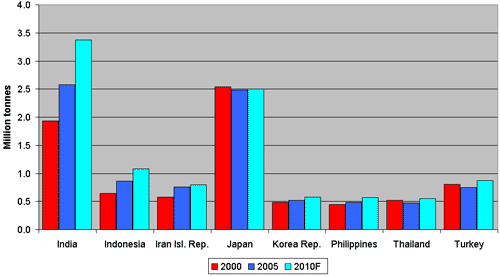



GLOBAL POULTRY TRENDS - Expanding Role for Eggs and Products in Asia
Continued significant growth is anticipated in the production of both shell eggs and egg products in Asia, writes experienced industry watcher, Terry Evans, in the first of a new series of Global Poultry Trends, which will examine the present and future trends for the world's egg industries by region, starting with Asia.Between 2000 and 2009, Asia's output of hen eggs expanded by eight million tonnes or 2.7 per cent per year from 29.1 million tonnes to 37.1 million tonnes. Asia's rate of growth outpaced that for the global total of 2.3 per cent per year, when output escalated from 51.1 million tonnes to an estimated 62.4 million tonnes. For 2010, it is estimated the world total will increase to around 63.7 million tonnes, of which Asia could well account for some 38.3 million tonnes (table 1). In which case, over the current decade Asia's share of world egg production will have risen from just under 57 per cent to a shade over 60 per cent.
As with our analysis of Asia's chicken meat production, only a handful of the 47 countries in the region account for the bulk of egg output. China alone represents 64 per cent of the regional total and, even if this country is excluded, then 79 per cent of the remaining 13.7 million tonnes of this year's estimated output will likely come from just nine countries (table 2).
Information about China's industry is hard to come by and the data can vary greatly according to the source, as the figures may be official, semi-official or estimated.

At the outset, it is important to note the difference between poultry eggs and hen eggs. For 2009, the provisional figures put out by the Food and Agriculture Organisation (FAO) indicate that poultry egg production in China amounted to around 27.9 million tonnes, however, hen egg production is estimated at 23.9 million tonnes, the difference mainly being accounted for by duck eggs. The commercial laying flock, of which over 80 per cent are brown eggers, is housed in cages.
At the start of the current decade, Japan was the second largest producer of eggs with an annual output of some 2.5 million tonnes. However, in the ensuing years this country's production has stagnated, while India's industry has grown by some six per cent per year from 1.9 million tonnes to exceed three million tonnes, pushing Japan into third place in the production league (table 2). Japan's laying flock has varied only slightly around 140 million birds over the decade and is unlikely to expand because of limits on land and the supply of domestically produced cereals. Virtually all the birds are kept in conventional cages, the majority, around 60 per cent, being white egg layers.
The rapid growth in India has resulted in the flock exceeding 150 million and our estimate of an output 3.4 million tonnes for 2010 could well be on the low side. The outlook is for continued relatively rapid expansion reflecting a growth in domestic demand and also of exports. Like the commercial sector in most other Asian countries, all the birds, which are white eggers, are housed in cages.
Although Indonesia comes fourth in our production league table, after rapid expansion to 2004, the industry was then hit by outbreaks of avian influenza and since 2005, output has stabilised at a little over one million tonnes a year.
Some increases have been evident in recent years in Turkey and current production is likely to be at a record level approaching 900,000 tonnes. Again, the bulk of the flock are white eggers, all being housed in cages.
Iran has clearly become an increasingly important producer in the region, output having risen by more than 70 per cent in the current decade to possibly 800,000 tonnes in 2010. Only white eggers are raised all housed in conventional cages.
There are five countries recording annual production of between 500,000 and 600,000 tonnes: the Republic of Korea, Thailand, the Philippines, Pakistan and possibly, Malaysia.
Reports from Thailand have indicated that extremely high temperatures in the middle of 2010 caused considerable stress to the laying flock and this, combined with the effect of the heat on water supplies and quality, depressed egg output.
It has been hard to assess how badly the severe flooding of 2010 impacted on Pakistan's industry but the remaining three countries in this group appear to be optimistic for continued growth.
Although considerably smaller in size, the egg industries in Azerbaijan, Kazakhstan, Kyrgyzstan, Myanmar, Tajikistan, Turkmenistan, Uzbekistan, Viet Nam and the Yemen have all recorded well above average growth rates since 2000.

| - | You can view other articles in our series Global Poultry Trends by clicking here. |
January 2011










